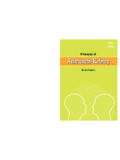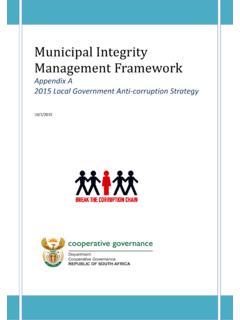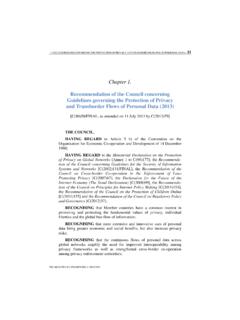Transcription of Crime scene and physical evidence awareness for …
1 *0981977* Crime scene and physical evidence awarenessfor non-forensic personnelVienna International Centre, PO Box 500, 1400 Vienna, Austria Tel.: (+43-1) 26060-0, Fax: (+43-1) 26060-5866, nations publicationSales No. 978-92-1-130273-8ST/NAR/39 Printed in April 2009 1,140 FOR united nations USE ONLYP hoto credits:UNODC Photo LibraryLaboratory and Scientific SectionUnited nations office on drUgS and crimeViennaCrime scene and physical evidence awareness for non-forensic personnelUNITED NATIONSNew York, 2009 This publication has not been formally he steps, whatever he touches, whatever he leaves, even unconsciously, will serve as silent evidence against him.
2 Not only his fingerprints or his footprints, but his hair, the fibers from his clothes, the glass he breaks, the tool mark he leaves, the paint he scratches, the blood or semen he deposits or collects - all these and more bear mute witness against him. This is evidence that does not forget. It is not confused by the excitement of the moment. It is not absent because human witnesses are. It is factual evidence . physical evidence cannot be wrong; it cannot perjure itself; it cannot be wholly absent. Only its interpretation can err. Only human failure to find it, study and understand it, can diminish its , Paul, Crime investigation, John Wiley & Sons Canada, Limited, 1953 united nations PUBLICATIONS ales No.
3 978-92-1-130273-8ST/NAR/39iiiAcknowledge ments ivIntroduction and purpose 1 PART IThe value of physical evidence and the concept of chain-of-custody 4 Forensic science services and the Crime scene investigation process 4 Legal, ethical and human dignity considerations 5 Health and safety considerations 6 PART IIPlanning, organization and coordination of the work at the scene 8 Preservation of the scene and its evidence 10 Documentation of the scene and its evidence 12 Recognition, recovery and preservation of physical evidence 13 Transportation, storage and submission of evidence to the laboratory 15 Annex Types of physical evidence potentially present at Crime scenes, and their evidential value 17ivACKNOWLEDGEMENTSThis manual was conceptualized by the Laboratory and Scientific Section (LSS) of the united nations office on Drugs and Crime (UNODC) with inputs from the Inter-national Committee for the Red Cross (ICRC) and the office of the united nations High Commissioner for Human Rights (OHCHR).
4 The development of this manual would not have been possible without the valuable contributions, at different stages of the process, of the following experts. To them, UNODC wish to express its appreciation and thanks:Joseph ALMOG, Professor of Forensic Chemistry, Hebrew University of Jerusalem, IsraelChristina BERTLER, Senior Adviser, SKL (Statens kriminaltekniska laboratorium), SwedenBob BRAMLEY, Formerly chief scientist of the FSS (Forensic Science Service), united KingdomDavid CLARKE, Former Government Chemist, Government Laboratory, Hong Kong, ChinaRainer DAHLENBURG, Forensic Consultant, Afghanistan Country office , UNODC and Forensic Chemist, BKA (Bundeskriminalamt)
5 , GermanyPeter DE FOREST, Former Professor of Criminalistics, John Jay College of Criminal Justice, University of New York City, united StatesJan DE KINDER, Director, INCC/NICC (National Institute for Forensic Science and Criminology), BelgiumRamon DIAZ, Forensic Scientist, Criminalistics Laboratory, Institutes of Forensic Sciences, Puerto RicoBarry FISHER, Director, Los Angeles County Sheriff s Department Crime Laboratory, united StatesUte HOFMEISTER, Forensic Advisor, Assistance Division, ICRCMax HOUCK, Director, Forensic Science Initiative, West Virginia University, united StatesSusan JOHNS, Consultant, Susan Johns Forensic Consulting Inc, Illinois, united StatesChris LENNARD, External Scientific Advisor, Australian Federal Police and Professor of Forensic Studies, Faculty of Applied Science, University of Canberra, AustraliavSC LEUNG, Former Assistant Government Chemist / Former Chief.
6 Government Laboratory, Forensic Science Division, Hong Kong, ChinaAdriano MALDANER, Director, Forensic Chemistry Laboratory, Federal Police, BrazilTofik MURSHUDLU, Project coordinator, Kazakhstan Project office , UNODCS teve NASH, Past President and Crime scene Certification Board member, International Association for IdentificationAntoanela PAVLOVA, Human Rights Officer, Peace Missions Support and Rapid Response Unit, OHCHRP eter PFEFFERLI, Director, Forensic Science Division, Zurich Canton Police, SwitzerlandFlemming QUIST, Law Enforcement Advisor for Africa, Regional office for Western and Central Africa (ROSEN), UNODCTony RAYMOND, DNA Advancement Program Director and Acting Chief Scientist, Forensic Services Group, NSW Police Force, AustraliaRoberto RICCI, Chief, Peace Missions Support and Rapid Response Unit, OHCHRJ ames ROBERTSON, National Manager Forensic and Data Centres, Australian Federal Police, AustraliaNorah RUDIN, Forensic DNA Consultant, united StatesMorris TIDBALL-BINZ, Forensic Coordinator, Assistance Division, ICRCThe preparation of this manual was coordinated by Magali Bernard and Barbara Remberg, staff of the UNODC LSS (headed by Justice Tettey).
7 The UNODC LSS is grateful to all other UNODC colleagues who contributed to the manual. 1 Every incident, be it a Crime , accident, natural disaster, armed conflict, or other, leaves traces at the scene . The goal of the subsequent investigation is to correctly interpret the facts, reconstruct the events and understand what to the transient and fragile nature of those traces, their reliability and the preservation of their physical integrity depend to a very large extent on initial actions at the scene of the incident. evidence integrity can be achieved with very limited means by observing a key set of guiding principles. Acting with care and professionalism throughout the Crime scene investigation process is critical for the admissibility of evidence for court purposes as well as for human rights inquiries and humanitarian action.
8 The present manual was prepared to fill a gap in the compendium of available tools for the judiciary and law enforcement agencies and is the result of a consultative pro-cess involving a number of reputable individuals, institutions and organizations, who contributed a variety of different perspectives to this cross-cutting issue, all grounded in the same basic principles common to all Crime the sake of simplicity, the term Crime scene is used in this manual to refer to any scene of incident that contains records of past manual aims at raising awareness of the importance of good practices in Crime scene investigations and the nature and relevance of physical evidence .
9 It covers issues related to the work at the scene , from the actions of the first responder(s) to the submis-sion of evidence to the laboratory. As such, it provides the very basis for enabling more evidence -based reconstruction of primary target audience of the manual is non-forensic personnel, first responders and any person involved in the Crime scene investigation process without full-fledged training, to help them understand the importance of their actions and the consequences of not applying basic principles of good practice. The manual also targets policymakers, the judiciary and others having to assess, and/or base decisions on evidence presented to an awareness -raising tool for non-forensic personnel, the manual provides a basic outline of the Crime scene investigation process with a focus on why individual steps and actions are essential.
10 An Annex provides examples of physical evidence that can be recovered from Crime scenes, the information that can be obtained from subsequent forensic examinations, and sample cases where different types of physical evidence might be encountered. 2It is important to note that the manual is not a guide for Crime scene investigations, neither for first responders nor for Crime scene investigators. Detailed checklists and guidelines for preserving, documenting and processing Crime scenes are available elsewhere and should be consulted where practical, hands-on guidance for work at the Crime scene is required. Those guidelines are typically used in combination with train-ing courses.

















